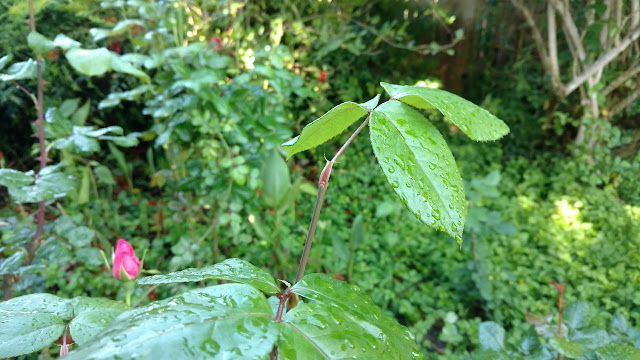

|
|
A blind shoot on this Miss Congeniality rose will never produce a flower, even though there are blooms elsewhere on the bush. (Photo: Debbie Arrington)
|
Usually, June is full of roses in my Sacramento garden. It’s the second wave of bloom after the big burst of first roses in April.
But not this year. Where there should be buds, there are only stubs.
Those are “blind shoots,” growth that never produces a flower.
In early May, I dutifully deadheaded spent blooms to prepare the bushes to generate new buds. But May’s confusing weather – triple-digit one week, 30 degrees cooler the next – created equally confused plants. Is it August? Is it March?
The stems look healthy with lots of foliage and fast growth. But no matter how long those stems grow, they won’t sprout a bloom.
Blind shoots are the result of extreme fluctuations in temperature and growing conditions. Our yo-yo
weather confused many bushes, especially when temperatures plunged back below normal.
Another oddity: Blind shoots can appear on the same bush with normal blooming stems.
Some rose varieties are more sensitive to temperature fluctuations than others. But this week, I’ve seen blind shoots on more than 100 bushes in my own garden. They’re appeared on almost every hybrid tea in my garden as well as most of the floribundas and many miniatures. Even the David Austin shrub roses have blind shoots.
This is a condition on modern reblooming roses, which covers most varieties commonly grown in home gardens. Old garden varieties introduced more than a century ago include many once-blooming roses such as Lady Banks banksia roses or Dorothy Perkins ramblers. Their growth after initial spring bloom is all foliage, no buds.
But modern roses are valued for their reblooming qualities. And an abundance of blind shoots will prevent the bush from producing new buds this summer.
Fortunately, the cure for blind shoots is easy: Prune them off. Restart the growth by cutting the cane or shoot back about 5 or 6 inches, snipping about 1/2-inch above a leaf with five leaflets.
So, I’m back deadheading my roses again, but all I’m snipping off this round are a bunch of stubs. Hopefully, if weather cooperates, I’ll have a new round of blooms – in August.
Comments
0 comments have been posted.Sacramento Digs Gardening to your inbox.
Sites We Like
Garden Checklist for week of July 21
Your garden needs you!
* Keep your vegetable garden watered, mulched and weeded. Water before 8 a.m. to reduce the chance of fungal infection and to conserve moisture.
* Feed vegetable plants bone meal, rock phosphate or other fertilizers high in phosphate to stimulate more blooms and fruiting. (But wait until daily high temperatures drop out of the 100s.)
* Don’t let tomatoes wilt or dry out completely. Give tomatoes a deep watering two to three times a week.
* Harvest vegetables promptly to encourage plants to produce more. Squash especially tends to grow rapidly in hot weather. Keep an eye on zucchini.
* Pinch back chrysanthemums for bushy plants and more flowers in September.
* Remove spent flowers from roses, daylilies and other bloomers as they finish flowering.
* Pinch off blooms from basil so the plant will grow more leaves.
* Cut back lavender after flowering to promote a second bloom.
* It's not too late to add a splash of color. Plant petunias, snapdragons, zinnias and marigolds.
* From seed, plant corn, pumpkins, radishes, winter squash and sunflowers.